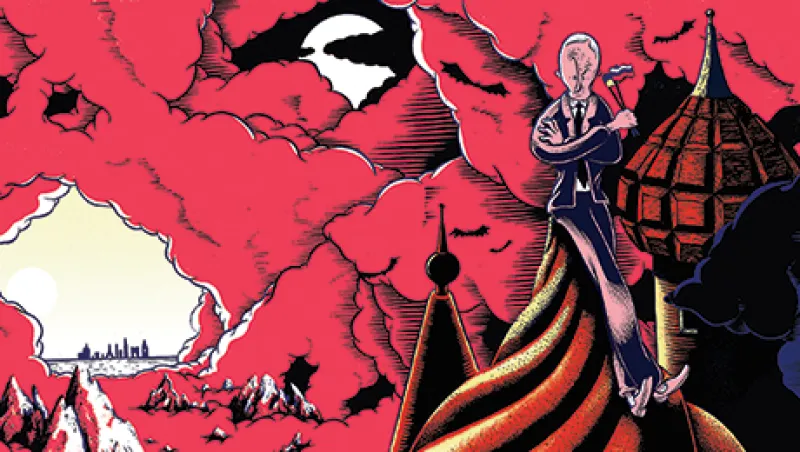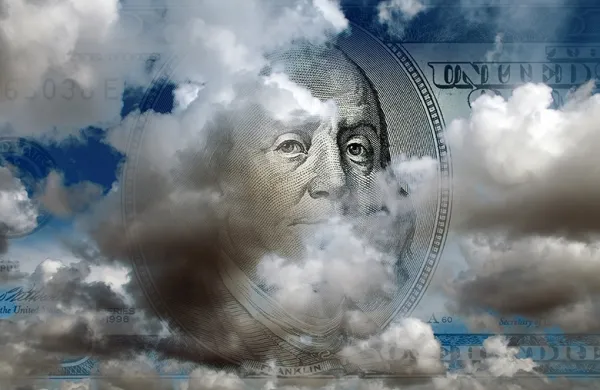A Russian analyst who has monitored corporate credit for the past decade at a Big Three rating agency in Moscow still maintains the habits of the go-go years,
enjoying a steak tartare lunch at a plush restaurant just off the capital’s Garden Ring, but his outlook for the country is grim — and not only in economic terms. He worries about the official media’s increasing focus on a “fifth column” supposedly seeking to undermine Russia from within, and about events like the 35,000-strong February march in Moscow, encouraged by the government, that was directed against “internal enemies.” Such efforts to stifle dissent and rally support for the government’s policies toward Ukraine could metastasize into a modern version of Stalinism, he warns.
“The space for living in this country is contracting,” the analyst says, pressing his hands together. “We have to remember that Russia killed more of its own citizens than any other nation in history.” He adds that he is thinking about emigrating to Canada, where he has relatives.
A British banker who has lived in Moscow since the 1990s sips a double cappuccino amid a bustling after-work crowd at the Taganka Square branch of Le Pain Quotidien, a Belgian café chain that has mushroomed around the capital in recent years. Laid off from a Western-backed hedge fund that is shrinking its operations in Russia, he is having his apartment valued and mulling starting over again in London.
Marina Treshchova, the fireball CEO of Moscow-based Internet incubator Fastlane Ventures, used to stay late at the office poring over business plans when she wasn’t racking up air miles calling on investors from Boston to Berlin. Now she is finding more time for the quieter joys of caring for her two young children. “The requirements of managing our portfolio right now allow me to work from home a lot more,” she says in a subdued tone.
A visit to Moscow offers little evidence to support the assertion of U.S. President Barack Obama that Russia’s economy is “in tatters,” but neither does it back up the argument of President Vladimir Putin that Russia has hit bottom and is poised for recovery. Key market indicators have seen a modest bounce in 2015, with the MICEX Index of Russian stocks up 20.5 percent for the year as of April 20. The ruble has stabilized after losing almost half its value in 2014.
“I’m very optimistic about the future of Russia,” veteran investor Jim Rogers said last month at a Moscow conference organized by Russia’s top stock brokerage, BCS Financial Group. “Certainly, one of the most attractive stock markets in the world for me these days is Russia.”
Such optimism is tough to find in corporate Russia itself. The country’s real economy continues to deteriorate: According to the International Monetary Fund, the economy is set to contract by 3.8 percent this year after expanding by just 0.6 percent in 2014, and it will keep shrinking into 2016 barring an unexpected upturn in oil prices. Inflation is raging at an annual rate of more than 15 percent, meaning real wages will drop by 10 percent this year, estimates Yulia Tseplyaeva, chief economist at state-owned banking giant Sberbank. Corporate lending has screeched to a near-halt, with domestic prime interest rates at 14 percent and foreign credit mostly choked off by sanctions. Unemployment, which hit a record low of 4.8 percent last August, increased to 5.9 percent in March and will almost certainly rise further, economists and executives say. In March the government announced it was revising its budget for 2015 to cut federal spending by 2 percent and would withdraw 3.1 trillion rubles ($58.5 billion) from the Reserve Fund, one of its two big contingency reserves, to support spending and limit the rise in the budget deficit. “The full effect of the crisis will be felt only over the next three to six months,” says BCS chief economist Vladimir Tikhomirov.
If and when the recession ends, analysts, investors and business executives harbor few hopes of a forceful recovery. The sharp drop in the price of oil — Russia’s chief export — and sanctions imposed by the European Union and the U.S. in retaliation for Russia’s annexation of Crimea and perceived proxy war in eastern Ukraine have taken a big toll on the economy. Even before those recent woes, however, the economy had been slowing sharply from the combined impact of long-standing bureaucracy and corruption and the waning of an unsustainable boom in corporate and consumer credit. “It’s easy to forget now that we grew just 1.3 percent in 2013, when Brent oil averaged more than $100 a barrel,” notes Tseplyaeva.
Getting Russian growth back up to the average global rate of 3.5 to 4 percent, a level the country easily exceeded for much of the past decade, would require substantial improvement in all of those trends, market participants say. For now that looks unlikely. The U.S. Energy Information Administration forecasts that Brent crude will average $59.50 a barrel this year — up from the recent lows but slightly below its late-April level of $62.77 — then rise to $75 in 2016. Although that would be a welcome recovery, such prices would hardly put the Russian economy back on steroids. On the geopolitical front Putin seems more inclined to escalate tensions in Ukraine than make concessions and to maintain a broader war of nerves with the West that has resulted in nuclear-armed Russian bombers regularly cruising off the coasts of the U.K. and Norway. And in his 15th year of what has become near-absolute power, Putin shows no sign of embracing the deep structural reform that’s needed to invigorate the economy.
The consensus outlook, then, is for a sort of permanent crisis that will erode Russia’s economic health even as Putin seeks to reclaim the country’s big-power status. “We should be prepared that the current environment of sluggish or negative growth will continue for quite some time,” says Alexey Kornya, chief financial officer of Russia’s top cellular carrier, Mobile TeleSystems. “This is the new normal.”
“WHAT I FEEL FROM GOVERNMENT officials is a lot of complacency,” says Viatcheslav Pivovarov, a former adviser to Russia’s Ministry of Economic Development and Trade who now runs a $50 million hedge fund firm, Altera Capital, in Moscow. “They assume oil will go back up eventually and they can muddle through until then.”
Putin and his lieutenants have good reason not to panic or rush a settlement in Ukraine: They still have a substantial financial buffer amassed during the years of strong oil prices, although they have been draining those resources rapidly. The Central Bank of Russia (CBR) has $356 billion in reserves, down from a peak of $545 billion in August 2011. The government has an additional $149 billion in two rainy-day vehicles, the National Welfare Fund and the Reserve Fund, but the budgetary drawdown will shrink the latter fund to one third of its size at the start of this year. Last, the regime can rely on a population that for now is willing, if not eager, to sacrifice in the name of patriotism.
Genuine support for Putin may not be as high as the approval ratings of 85 percent or so that are frequently cited. It’s a rare Russian who would express disapproval of the president to a stranger over the telephone. But a large majority clearly endorses the official view that last year’s Ukrainian revolution sprang from a U.S.-backed plot to encircle Russia, and they seem to believe that Moscow’s response is the minimum required to ensure national security.
A Muscovite engineer who has traveled the world for more than a decade as an employee of an American contractor bristles at the idea that Russian policy provoked the West’s economic sanctions. “This is some conspiracy you put together against us,” he says. A senior banker breaks off a dry discussion of loan-loss provisions and capital ratios for a disquisition on the Crimean War — not the Russian seizure of that territory last year but the conflict of 1853–’56, in which Britain and France bombarded the cities of Odessa and Sevastopol and defeated Russia’s bid to project military power across the Black Sea. “If it weren’t for our nuclear weapons, they would be bombing Moscow now,” he concludes.
Such nationalist ardor has made it easy for Russian policymakers to let the ruble drop broadly in line with oil prices, then resort to shock-and-awe rate hikes to support the currency without much fear of popular discontent, analysts say. So far, that policy has worked in several respects.
The central bank has conserved its firepower more effectively than during the global financial crisis of 2008–’09. From July 2014 to March 2015, the CBR depleted its reserves by $125 billion to finance currency intervention, support commercial banks and provide a controversial R700 billion loan guarantee for heavily indebted state oil giant Rosneft. That was much less than the $218 billion spent in the six months following August 2008.
The ruble devaluation has cushioned the impact of petroleum prices on Russia’s budget because the state collects key taxes from exporters based on their hard currency earnings, then meets its own bills in rubles. In late March the Duma passed a revised 2015 budget calling for a reduction in spending, to R15.2 trillion this year, and a deficit of 3.7 percent of gross domestic product — profligate by recent Russian standards but well in line with global practice during a downturn. Crucially, the budget math allows Putin to maintain promised increases in the nominal value of pensions and other social payments.
The ruble depreciation has bailed out Russia’s key commodity industries, whose losses from falling prices have been significantly offset by declining ruble costs at home. Mining giant Norilsk Nickel, for example, reported a 14 percent drop in costs during 2014, which helped boost earnings before interest, taxes, depreciation and amortization by 35 percent, to $5.7 billion. Positive cash flow at resource titans like Norilsk eases Russia’s most urgent macroeconomic problem, repaying the $600 billion or so that its corporations borrowed from foreign banks and bondholders, most of which will not roll over those debts. Russia Inc. repaid some $130 billion of hard currency debt during the nine months through March 31, leaving $60 billion or so for the remaining three quarters of this year, according to CBR data. “The critical stage on debt repayments has passed,” BCS’s Tikhomirov says. “The volumes are lower going forward, and the companies are earning money.”
Almost half of the foreign borrowing was raised from Russian companies’ offshore subsidiaries, estimates Mikhail Matovnikov, Sberbank’s chief analyst. These transactions were typically conducted for tax purposes, says Tikhomirov. For instance, a Russian company might lend to a foreign subsidiary at an interest rate of 2 percent and borrow back from that unit at 7 percent to reduce declared earnings at home.
The fact that Russia’s sky is not falling just yet spells tactical opportunity for some specialist investors. Altera’s Pivovarov says he has raised
$100 million to invest in the hard currency bonds of Russian issuers. Yields on four-year paper issued by state diamond monopoly Alrosa were trading at about 12 percent last month; some bonds issued by state-owned VTB Bank sport yields as high as 20 percent. Firebird Management, a New York–based hedge fund manager focusing on equities in Eastern Europe and Eurasia, has whittled its Russian exposure from about $1 billion in 2007 to $300 million today but sees ways to profit on what is left.
“Russia these days is a sideways market at best, but from a bottom-up point of view you won’t find an oil company better valued than Lukoil,” says Firebird co-founder Harvey Sawikin, referring to the country’s largest privately owned producer. Lukoil’s London-listed shares have rebounded by one third this year after a similar drop in the second half of 2014. Other Firebird picks include potash producer Uralkali and Sberbank; the latter’s London shares have cratered by 60 percent since the Ukraine uprising last February.
But the twin currency and credit shocks are taking a vicious toll on the growth industries Russia once looked to for diversification away from raw materials, and they are gradually undermining investment at blue-chip companies. New-car sales fell by roughly half in the first quarter of 2015 from the same period last year. Mass-media ad revenue slumped by one third. Top residential real estate developer Etalon Group slashed its 2015 construction targets by 28 percent in March, to 5.4 million square feet. Commercial rents are dropping precipitously, promising more expensive ghost projects like the Moscow City financial center, whose 70-story towers loom mostly vacant over the Moskva River. “This is a time when you can renegotiate anything with your landlord or suppliers,” says Michael Calvey, senior partner at Baring Vostok Capital Partners, a veteran, Moscow-based private equity investor.
Big players are restraining capital expenditure, too, though more subtly. Cellular power MTS will shave its Russian capex by 9 percent, according to CFO Kornya. That amounts to a real reduction of more than 20 percent after taking inflation into account. “We are struggling to maintain free cash flow and moving to a higher threshold for investment projects,” he says.
At the center of this implosion is a banking system that has effectively become a ward of the state. “The ultimate source of all funding right now is the central bank,” Kornya explains. “Borrowers can use different intermediaries.”
Russian banks entered the current crisis still weak from the global financial meltdown, says Alexander Danilov, Moscow-based sector analyst for Fitch Ratings. Average capital-to-asset ratios stood at 12 percent, comfortably above the CBR’s 10 percent minimum requirement but down from 16 percent in January 2008. Yet 6 percent of loans were already nonperforming — more than twice the pre-2008 level — when Ukrainian president Viktor Yanukovych fled Kiev in February 2014.
The situation will only get worse in the next 12 to 18 months, Danilov predicts. NPLs will likely exceed their 2009 peak of 10 percent while rising funding costs are eating into banks’ net interest margins. “The banks could legally raise rates on existing loans, but this is sometimes not possible economically,” he says. Russian banks need to repay their own foreign creditors some $40 billion this year, roughly equal to the amount of liquid hard currency assets they hold, Fitch estimates.
The CBR, with some help from other state organs, is riding to the banks’ rescue. Earlier this year the central bank announced a series of what professionals call forbearance measures — and outsiders might call creative accounting — to shore up financial institutions’ books. Banks may compute the value of hard currency loans, some 20 percent of the system’s portfolio, at the exchange rates that prevailed in the third quarter of 2014. At that time, the ruble traded at about 36 to the dollar, nearly a third below the level of 53.57 to the dollar in late April. By allowing the banks to ignore a large increase in the ruble value of those hard currency loans, the CBR spares them the need to raise fresh capital to back those loans. The regulator extended other forbearance to banks, permitting them to not mark their securities books to market prices and not create provisions for restructured exposures and loans to Ukrainian borrowers.
Direct state support is pouring into the banking system. The CBR and the national development bank, Vnesheconombank, have allowed banks to convert R845 billion in subordinated loans advanced after the 2008–’09 crisis into tier-1 capital. The Deposit Insurance Agency has made an additional R1 trillion available for capital injections to 27 systemically important banks. The CBR has also provided banks with up to $50 billion in repurchase agreements to help companies refinance external debts and pumped up domestic liquidity with increases in collateralized lending.
Overall government funding has swelled to nearly three times its 2009 peak, to some R9 trillion, or 15 percent of the banking system’s liabilities, Fitch says. The net effect is that Russia’s financial heart should be able to keep beating for two years or so while awaiting better weather, Danilov concludes. “Economically, this is a slow-burn situation,” he says.
If Russia were suffering through a simple commodity-crash contraction, two years might well be long enough to restore economic vigor. Oil prices have firmed in recent weeks, with Brent trading at nearly $64 a barrel in late April. A sharp slowdown in consumer spending should help cool inflation and allow the central bank to cut rates. The CBR has already lowered its key rate twice since January, reducing it by a total of 3 percentage points, to 14 percent; Danilov expects it to come down to 10 percent by year-end, below the 10.5 percent rate that prevailed before the Ukraine crisis erupted.
Such monetary easing would provide a welcome breather for stretched Russian companies and lure foreign investors back to the market to take advantage of low asset prices. Russia could emerge a more diversified, less import-dependent economy, with costs better aligned with its productive capacities. Yet hopes for this rosy scenario are thin among Moscow’s business class because of the country’s structural, and what Russians euphemistically call geopolitical, challenges.
The Kremlin is pushing to increase import substitution as a way of getting around economic sanctions. Proposed projects range from the visionary — establishing the Technopolis special economic zone on the grounds of Moscow’s defunct Moskvich auto plant to nurture high-tech companies — to the fanciful: Putin last month ordered officials to consider R972 million in state funding for a proposal, suggested by patriotic film director Nikita Mikhalkov, to create a domestic alternative to McDonald’s called “Let’s Eat at Home.”
Russia has had some experience with import substitution, but the last such example took place under very different conditions, following the country’s 1998 default, Sberbank’s Tseplyaeva notes. Then, wages were low; unemployment was above 10 percent; and more than half of the industrial capacity, dating to the Soviet era, was sitting idle. Today’s Russia has little slack capacity and nearly full employment. “Increasing production for import substitution or anything else requires investment in raising labor productivity,” she points out. That, in turn, requires capital, which is in very short supply right now, and in all likelihood imported machinery and software, which ruble depreciation has made much more expensive. In a January survey by the Moscow-based Gaidar Institute for Economic Policy, 62 percent of Russian managers reported it would be “complicated” to find Russian-made replacements for their foreign-bought inputs. A further 35 percent said the Russian alternatives were of lower quality.
Above all, investment requires confidence in the future, which today’s Russia does not inspire. The Western sanctions are mild on paper, banning loans of longer than 90 days to less than a dozen state-controlled companies. The EU may water down its measures when they come up for renewal in July, as a result of pressure from Greece and Hungary, which the Kremlin has been wooing in recent months. But the sanctions have broadened into a general financial blockade because no one knows what Putin and the hybrid military forces he has uncaged in Ukraine will do next; the Russian president has shown himself willing to sacrifice his country’s economic well-being to the more obscure goal of restoring its self-respect and international sphere of influence.
The start-up websites that Fastlane Ventures funds, helping consumers to buy cars or access medical advice, are far from being potential sanctions targets. Yet the network of U.S. and European private equity investors that the Russian incubator was counting on for second-stage backing has dried up completely, CEO Treshchova says. “No one knows what Russia will look like three to five years from now and whether they will find liquidity for an exit,” she says. “It’s very painful to us, as a lot of our sites had gotten to breakeven and were ready to grow to scale.” Instead, Fastlane has shut down seven of its 16 properties, including four sites focused on real estate.
Baring Vostok’s Calvey — who has worked in Russia since 1994 and made his backers a fortune with an early investment in the country’s dominant Internet search provider, Yandex — still sees tempting targets for his firm’s $1 billion cash hoard in global growth sectors like the Internet and health care. “The entrepreneurial sector here is as good as it is in most places,” he says. “There are first-rate people with whom to build businesses and do things.”
But Calvey is in no rush to grab assets at current valuations, instead intending to mete out his powder over the next three years as he casts a wary eye on Moscow’s international relations. “We are not expecting the window of opportunity to expire,” he says. “The political isolation of Russia could last for a long time.”
Sergey Riabokobylko, managing partner in Russia for global real estate company Cushman & Wakefield, takes a more impassioned contrarian bullish view, urging investors to scoop up distressed Russian real estate sooner rather than later. “The window of opportunity is over the next six months,” he maintains. “We may already see a pickup in volume during 2016.” But he adds, “Of course, if we take Mariupol, all bets are off.” He refers to the eastern Ukrainian city presumed to be the next target of Russian-backed rebels, as it would open a land corridor between Russia and Crimea.
Multinational corporations have longer-term commitments to Russia’s market of 143 million people, the world’s No. 9 economy, with output above $2 trillion, according to the IMF’s 2014 data. But even among big foreign direct investors, the tendency is to retreat. In March, General Motors Co. announced it would terminate Russian auto production, taking a charge of $600 million. Vienna-based Raiffeisen Bank International, the largest foreign bank in Russia, said it would shut 15 branches in the country and slash risk-weighted assets there by 20 percent by 2017. PepsiCo and Coca-Cola Co., Russia’s leading sellers of nonalcoholic beverages, each announced plant closings in March. Danish beer maker Carlsberg, which owns the popular Russian brand Baltika, announced two brewery shutdowns in January.
Although those consumer-oriented investors have been reducing their exposure, French-U.S. oil services giant Schlumberger has showed some confidence in Russia, announcing in January a $1.7 billion deal to acquire 46.45 percent of local competitor Eurasia Drilling Co.
RUSSIA’S FIRST RESPONSE to the West’s financial freeze over Ukraine was a proclaimed pivot to the East. Putin visited China in May 2014 and returned assuring his countrymen that cash-rich Asians would rush in to replace Europe as lenders and investors. One year later that strategy has borne little fruit. “Step one for companies was to go to Asian markets, but it turned out that Asian markets are very Asia-focused, without much incentive to go elsewhere,” BCS’s Tikhomirov says.
State gas monopoly Gazprom has yet to line up financing for the signature project of Russia’s intended strategic reboot, a $55 billion drilling and pipeline complex needed to deliver a purported $400 billion worth of gas to China over 30 years. Analysts say the Chinese government is reluctant to advance the cash unless it can obtain stakes in Gazprom’s upstream fields, crown jewels that the Kremlin is not yet ready to pawn. Without Chinese help, sanctioned Gazprom would have to find a way to tap international credit markets again. Compounding Gazprom’s woes, on April 22 the European Commission launched an antitrust case against the company, accusing it of abusing its market dominance to inflate prices and impede rivals.
Putin’s narrowing options and the crisis’ mounting cost to ordinary Russians are spurring some faint hopes among economic liberals, who reason that conditions might just get bad enough to catalyze overdue changes. “Now is the best time to start structural reform,” Sberbank’s Tseplyaeva says. “Mr. Gref and the liberal wing of the government are very focused on this,” she adds, referring to Sberbank CEO and former Economic Development minister German Gref.
But the changes she outlines hardly seem adequate to shake Russia out of its lethargic new normal. First priority for the undaunted reformers is restoring the private savings component of the nation’s pension system, which Putin put on moratorium two years ago at the behest of the government’s social bloc, led by the Labor and Healthcare ministries. Gref has also called for a far-reaching but amorphous “reform of public administration” that involves “more cooperation between the federal and regional governments” and key performance indicators “to enhance the efficiency of each bureaucrat,” in Tseplyaeva’s description.
None of these measures would attack Russia’s core problems: grossly inefficient monopolies and lawless bureaucrats who alter the rules of the game at will to enrich connected individuals, starting with the president’s friends.
One thing has not changed in Putin’s Russia. It remains by far the most corrupt of the major emerging markets, according to Transparency International’s annual Corruption Perceptions Index. Russia ranked 136 out of 175 countries in TI’s 2014 survey, compared with 100 for China, 85 for India and 69 for both Brazil and Turkey.
If anything, the Russian state is spreading its tentacles farther in response to the latest crisis. Law enforcement began monitoring food wholesalers and retailers for suspected price gouging last September, and in March, Putin urged the authorities to show greater vigilance. “Illegitimate actions of resellers and retail merchants arbitrarily raising their prices must receive the appropriate legal response,” the head of state told a collegium at the Prosecutor General’s Office. These are ominous words for a sector of the economy that has until now developed independently. Days before Putin’s statement prosecutors in the Ural Mountains province of Sverdlovsk announced 50 different “administrative actions” against a regional macaroni producer for “impermissible” price rises of 8 to 10 percent, radio station Echo of Moscow reported.
Without some convincing reversal of the Kremlin’s autocratic and kleptocratic habits, a settlement of international tensions over Ukraine or an unexpected leap in oil prices, the prevailing outlook for Russia is for continued economic decline, in relative if not absolute terms. Prosperous democracies like Italy and France can stagnate in a stable fashion for quite some time, with citizens venting their frustrations at the ballot box or in private pursuits. Historically, emerging markets are more volatile, especially when they embark on military adventures.
Russians won’t be content forever to tighten their belts in exchange for a fraternal pseudo-state in the rust belt of eastern Ukraine, economist Tikhomirov predicts. “People can only stay focused on one idea for so long,” he says. “A year ago everyone was excited about the return of Crimea; now it’s old news. Without economic improvement, we might be in a complicated situation by 2018.” Russia’s next presidential election is scheduled for March of that year.
Russia’s slow burn might just turn into a larger conflagration. For now it is fizzling away. •






